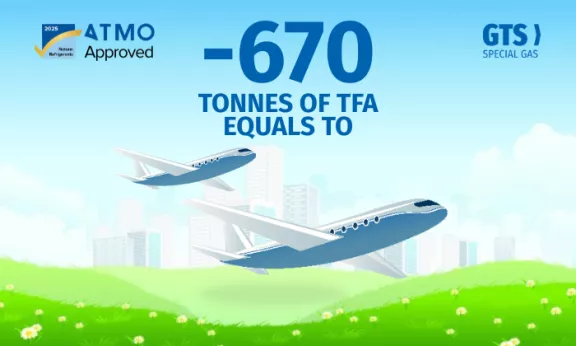In 2024, GTS achieved an environmental milestone that is worth more than a thousand words: by bringing natural refrigerants onto the market, it avoided 670 tonnes of trifluoroacetic acid (TFA), a substance belonging to the PFAS family that is one of the most persistent and environmentally damaging.
What is TFA and why is it a problem for the planet
TFA (trifluoroacetic acid) is a synthetic chemical classified as ultra-short-chain PFAS. PFASs are a group of compounds used in many industries for their non-stick, waterproofing and high-temperature resistant properties. However, they are also known as “eternal pollutants” because they do not easily degrade in the environment and accumulate in ecosystems and animal tissues, including humans.
TFA, in particular, is formed as a by-product of the degradation of many fluorinated refrigerants (HFOs) and often ends up in groundwater, rivers, lakes and even atmospheric precipitation.
The increasing presence of TFA in ecosystems is a real and concrete threat, so much so that it is the subject of attention from European and international regulatory authorities.
How did GTS avoid 670 tonnes of TFA?
GTS chose a different path: that of natural refrigerant gases, such as propane (R290), isobutane (R600a) and n-butane (R600), which do not produce TFA or other PFAS substances during their life cycle.
Thanks to this choice, in 2024 alone, the use of refrigerants prevented the formation of as much as 670 tonnes of TFA. This result was achieved thanks to widespread distribution, continuous market growth (+30% in 2024) and an industrial supply chain designed to guarantee quality, safety and minimal environmental impact.
Why is this important?
ATMOApproved recognition is confirmation that GTS is among the very few global companies that are concretely tackling the PFAS problem. ATMOsphere recently updated its certification criteria, requiring applicants to have a measurable impact on reducing CO₂ and TFA emissions.
GTS has demonstrated that it meets both requirements.
Eliminating PFAS from the cold chain is an environmental and industrial challenge of momentous proportions. Avoiding hundreds of tonnes of TFA means removing a huge amount of non-biodegradable substance from the water cycle, helping to protect water resources, public health and biodiversity.
What does 670 tonnes of TFA represent?
But how much is it, really, 670 tonnes? To give you an idea:
- That's like avoiding the annual PFAS discharge of an entire medium-sized chemical industry.
- That's the weight of almost two fully loaded Airbus A380s, but instead of travelling through the sky, these tonnes would end up in our seas, rivers and groundwater.
GTS: leadership that acts for a sustainable future
GTS's achievement is the result of an ongoing commitment, combining technology, environmental vision and industrial responsibility. TFA's reduction of emissions is just one piece of a broader strategy to decarbonise the cold chain and make industrial refrigeration safer and more sustainable.
With its natural refrigerants, certified production and measurable environmental impact, GTS continues to be a global benchmark for those who want to build a future without PFAS and without compromise.



